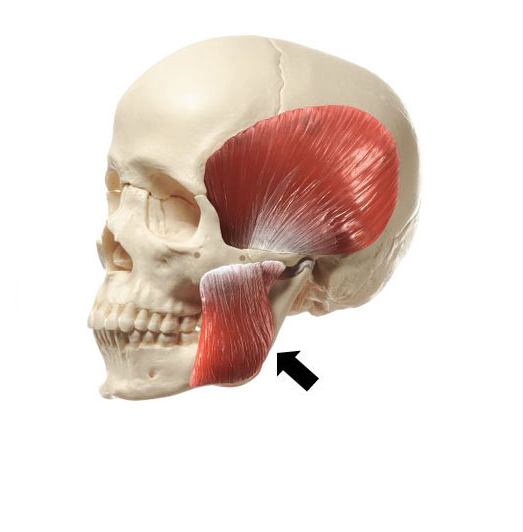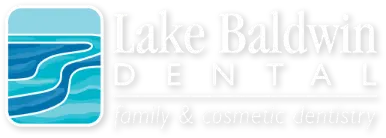A couple of months ago, we posted about how grinding has been causing problems for a lot of patients. Surprising to perhaps no one, this trend has not let up. I’m seeing more patients every day complaining of jaw pain, headaches, and sore teeth. There are so many ways to relieve that pain, but what can you do to feel better right now? Massage does wonders to relieve pain and tension in your jaw! Keep reading for tips on how to relieve TMJ pain with massage.
Basic Anatomy of the Chewing Muscles
Before you can massage your jaw muscles effectively, you need to know where they are and what they do! Here are the three main areas to focus on:
- The Masseter. The masseters are the big jaw muscles on both sides of your cheeks. They start just under the cheekbone and run down the back third or so of your cheek, and end at the bottom edge of the jawbone (see picture below). When you bite down, you’ll really notice them bulging.
- The Temporalis. The temporalis, as the name suggests, sits in the area of your temples. If you feel both sides of your head, just above and in front of the ears, you should find two depressions. The temporalis muscle runs in a big fan above that depression, starting behind the eyes and covering the side of the head all the way behind the ear.
- Upper Neck Muscles. There are muscles that run at the very top of your neck and into the base of the skull. Even though they might not seem like “chewing” muscles, they take a beating with grinding and clenching habits, and are a major culprit for the radiating pain sometimes associated with TMJ disorder.

Keys for Effective Massage
So now that you know where to focus, let’s discuss a general foundation to understand effective massage. We are looking for firm and relaxing pressure. Think of a handshake or a hug: not enough pressure, what was the point; too much pressure and you’re left wishing you’d gone for a fist bump instead.
Massage should create a sensation of pleasant release and may even cause some mild tenderness. That tenderness should always decrease as you work. Most importantly, massage should never cause intense or sharp pain, and should never cause pain to increase.
Don’t Forget the Warm-Up!
Massage is most effective on warm muscles. You can apply a warm compress to get some blood flow to the area. I also recommend some gentle warm-up exercises to get the blood flowing and soften the muscles. Here are a few suggestions:
- “Yes, No, Maybe so.” Pretty self-explanatory. Do some deep, slow head movements as you nod (“yes”), slowly draw your nose from one side to the other (“no”), and draw the shoulders up, and then roll them back and down (“maybe so”). All movements should be slow and easy, taking yourself almost to the comfortable end of your range of motion, but not pushing it. Repeat three reps of each for three rounds.
- Excursive movement. This means moving the jaw side to side. Again, move slowly and just inside your comfortable range of motion. Don’t strain. Try to keep the teeth slightly separated the whole time. Some sources suggest putting a tongue depressor or popsicle stick between the teeth and using that as a guide to slide across. About five on each side should do it.
- Opening and closing. If you do yoga, this is a mild version of lion face exercises. Open your mouth, extend your tongue, try to stretch your whole face, then return to a resting face. Move very slowly through opening and closing. It is extremely important that you DO NOT OVEREXTEND when you open your jaw. People suffering from TMJ disorders are sometimes prone to displacing the jaw joint. So take it easy on this one. It’s just a warm-up!
The Good Part
Okay, so we know what muscles we’re working, and we know how to get them prepped for some relief. Now what?
This link has a great step-by-step guide with useful photos to address each of these three main muscle groups. Basically, what you will do is find each of these muscles and gently let your fingers sit on the skin as you clench and release until you find areas where the muscles are tender or seem to bulge the most. Relax the jaw, then press into these areas for about ten seconds. Remember, firm, pleasant pressure. Then repeat for another area of the same muscle until it feels a little less tense.
When you address the temporalis, be sure never to put pressure directly on the temple. Go just above, below, in front or behind. But that tender spot right in the middle of the depression should be avoided.
Try to relax and engage the muscles as you apply pressure. I find a very small circular or sweeping motions sometimes help, but for trigger-point release, holding pressure on one spot for a few seconds can also work.
Here at Lake Baldwin Dental, we want you to enjoy your best possible pain-free dental health. Taking care of your TMJ is an essential step. If you might be clenching or grinding, let your dental health team know about it. We will do our best to get you out of pain as fast as possible. Keep smiling, Orlando!


